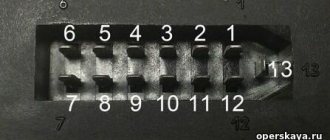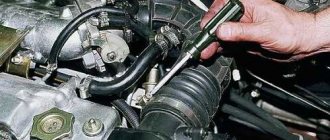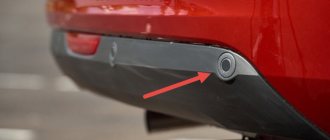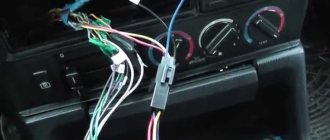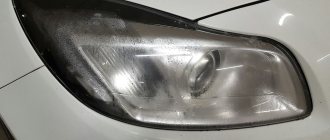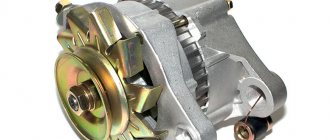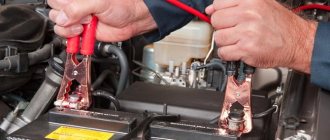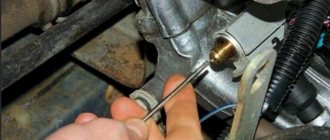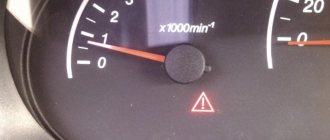Why does the smell of antifreeze appear in the cabin?
Sometimes an unpleasant odor appears even with normal sensor readings.
Ventilating the interior gives a temporary result - when the window glass is lifted, the problem manifests itself again. To completely solve it, you will have to establish its source. Typically, the cause of the odor is an antifreeze leak. The cooling system mechanisms fail as a result of prolonged use. The expansion tank itself could be depressurized or initially be of poor quality.
An antifreeze leak sometimes appears after an engine repair - if one of the hoses was connected incorrectly. Leaks can be quite difficult to detect. The fact is that antifreeze actively evaporates, and with a minor leak, the inspection may not yield results. But if the leak is quite severe, it can be easily detected by characteristic spots on the parts of the power unit. In this case, traces of coolant are also visible on the asphalt while the car is parked.
To ensure a high-quality connection of the cooling system hoses, use special metal clamps. They are reliable and can be used for a long time. Check the radiator. If it becomes depressurized, it is better to replace it, since it is difficult to repair the device.
The main causes of odor
It happens that there are no “symptoms”: the sensors transmit normal indicators, but the smell of antifreeze is felt in the cabin. Ventilation gives only a temporary effect. This means you need to go in search of the source of the problem. A leak can occur in almost any element of the cooling system, including the expansion tank. This occurs as a result of long-term use or the use of low-quality materials.
In some cases, the leak occurs because one of the hoses was connected incorrectly during engine repair. This problem is quite difficult to detect, since the liquid evaporates quickly and a regular inspection does not give much results. If the leak is severe, then characteristic stains will be visible on the parts of the power unit. In addition, such stains can also be found under the car if it is standing on a flat, dry surface.
To fix the problem with the hoses, it is recommended to use special metal clamps that ensure a high-quality connection. They are reliable and last quite a long time. The radiator should also not be ignored. If it depressurizes, it will require replacement, since repairing the device is complicated and not always justified.
Possible consequences and solutions
The antifreeze leak problem has several negative consequences.
- Technical. A leak will sooner or later lead to a critical drop in the antifreeze level and engine overheating. The coolant in the cabin will lead to accelerated oxidation of the contacts of the on-board electronics, since antifreeze is partially composed of water. And if there is a large coolant leak, this problem can even cause a short circuit in the electrical wiring.
- Operational. Systematic fogging of windows due to condensation of antifreeze leaving the system will constantly reduce visibility. The risk of getting into an accident will increase. Excessive humidity in the cabin will lead to the appearance of fungus and mold. And this is an additional source of unpleasant odor.
- Physiological. Ethylene glycol, the main component of the vast majority of modern coolants, is toxic to humans. The lethal dose ranges from 100 to 300 grams. In volatile form, when ingested through the respiratory system, its concentration in the body rarely reaches a dangerous level. However, systematic inhalation of vapors may cause dizziness, nausea, coughing and irritation of the mucous membranes. In addition, the smell of antifreeze is not pleasant for everyone and can become an additional irritant.
The best solution in this situation is repair and replacement of damaged elements of the cooling system. As a temporary measure, it is possible to use repair sealant for the radiator.
Reasons for the smell of antifreeze in the cabin
The sweetish smell of antifreeze in the cabin, especially noticeable after turning on the heater, always indicates one thing: there is a coolant leak in the system. There are four main ways antifreeze vapor can enter the cabin.
- Through a leaky heater core. This is the most common reason. If the smell is pronounced and is accompanied by leaks of antifreeze into the interior or systemic fogging of the car windows from the inside, then most likely the heater radiator is leaking. For example, on VAZ 2114 cars (and all models of the 10 series), as well as in the first generation Kalina, the heater radiator is made of two plastic reservoirs connected to aluminum honeycombs with fins. Leaks usually occur at the junction of plastic and metal. On more recent VAZ cars, such as Granta, Priora and Kalina-2, the heater radiator is all-aluminum. It usually destroys the honeycombs or breaks the supply pipes.
- Damage to the radiator supply or outlet pipes at their base. In this case, usually only an odor is observed in the cabin. There is no fogging of glass or smudges, or these factors are not clearly expressed. Depressurization of the system for this reason usually occurs at the joints. The pipes themselves are less likely to be damaged.
- Insufficient tightening of the clamps on the heater radiator pipes. Antifreeze leaks into this connection quite often. The most repairable fault. Eliminated by tightening the clamps.
- Violation of the integrity of the cooling system in any place other than the heater. In this case, only a slight smell of antifreeze is possible in the cabin. The entire engine compartment will also smell of antifreeze. The problem is usually accompanied by a sharp and noticeable drop in the coolant level in the expansion tank and overheating of the car.
There are several reasons for the destruction of pipes, radiators (central and heater), as well as other elements of the cooling system:
- low quality antifreeze;
- periodic use of water instead of a suitable coolant;
- untimely replacement of coolant;
- cavitation destruction;
- excess pressure in the system due to problems with the steam exhaust valve;
- overheating with boiling of liquid;
- natural wear and tear.
When the smell of antifreeze first appears in the car interior, you need to check the tightness of the system. Please note: some antifreezes contain special fluorescent components that glow under ultraviolet radiation. This helps to find even a small leak.
Malfunction: antifreeze runs out
Malfunction of the engine cooling system - “antifreeze leaks” is very common in used cars.
Using the example of carburetor engine 21083 of a VAZ 21093 (21083, 21099) car, we will try to understand its causes, diagnose them ourselves, and also give examples of what to do in such a situation.
Signs of malfunction: antifreeze is running out
Reduced fluid level in the expansion tank of the cooling system
A decrease in the level of antifreeze (antifreeze) in the expansion tank of the car engine cooling system is constantly or periodically observed. Below or close to the MIN mark.
There are coolant leaks on parts of the cooling system
At the connections of the engine cooling system parts there are traces of leakage (oozing) of antifreeze (antifreeze) - drips. There may also be leaks on adjacent parts (if the coolant splashes or drips).
In some cases, no drips may be observed, but the antifreeze still leaves. The reason for this is the evaporation of coolant from heated engine parts and other parts of the car. Or the leak occurs in a hidden, hard-to-reach place or where it is impossible to imagine. In the worst case, this is coolant getting into the combustion chambers or oil in the pan.
The smell of antifreeze (antifreeze) under the hood
A sweetish smell of antifreeze (antifreeze) when opening the hood of a car. May get worse as the engine warms up.
Drops or puddle of coolant under the car
Signs of a coolant leak
The smell of antifreeze in the cabin clearly indicates a malfunction in the car, regardless of the amount of coolant leaking. In most cases, such a malfunction is caused by a broken pipe or radiator. To do this, you need to carefully inspect all the parts under the hood to find any damage. The problem could also be due to a cracked radiator hose or a faulty gasket. It is much more difficult to notice the problem here.
The main sign that antifreeze is leaking is a specific smell in the cabin. The problem may also be accompanied by wet floor mats. In this case, the breakdown must be repaired immediately, since inhaling coolant vapors can lead to poisoning of the body with toxic substances.
We recommend: Audio system for your car
Another sign that antifreeze is leaking may be an increased engine temperature. As a rule, an indicator light on the control panel lights up when the antifreeze value is critically low.
What can a breakdown lead to?
We found out that the unpleasant odor is caused by a coolant leak. This leads to overheating of the engine - which can result in breakdown. Fumes are harmful to health - especially in the cold season, when the smell of antifreeze in the cabin only intensifies when the heater is turned on. Therefore, in winter, the malfunction must be eliminated even more quickly. You can do it yourself, but if you don’t have the skills, it’s better to turn to the experts.
A malfunction can add the following problems:
- Carpet, ceiling upholstery, sound insulation and other materials inside the cabin actively absorb and accumulate odors. Over time, they will become saturated with the unpleasant smell of antifreeze. It will always accompany the driver; no fan will help here.
- The coolant will leak out all the time - you will have to spend money on constant replenishment.
- The antifreeze that has dried after leaking crystallizes; these unnoticeable “crystals” will “flavor” the car’s interior.
It is not easy to determine the fact of a leak if the coolant gets under the timing drive. But upon careful inspection of the space under the belt, characteristic marks can be detected. Antifreeze can also get on the belt itself. This will cause the destruction of its structure. Typically, the cause of moisture on the timing belt is a faulty pump.
Heater radiator
When a coolant leak goes directly into the cabin and a distinct smell appears, which reappears even after ventilation, this may indicate poor sealing of the heating radiator. If this spare part leaks, even if it’s visually unnoticeable, part of the antifreeze goes straight into the car’s interior. At the same time, the driver and passengers of the transport almost always clearly smell a sweetish smell.
Timing belt is also one of the possible reasons.
Coolant can also be passed under the drive of the gas distribution mechanism itself. In this case, it is quite difficult to detect the leak that is occurring. You can look at the surfaces under the timing belt; there may be traces of moisture - coolant. As a rule, this indicates a pump malfunction.
How to find the cause of the breakdown?
The coolant constantly decreases while the engine is running. In winter, antifreeze evaporates when cooled. But all this is a normal operating process and does not cause the smell of antifreeze in the cabin. If the coolant comes out in large volumes or is consumed faster than expected, then we can talk about a malfunction.
How to find the cause of a breakdown based on symptoms?
- Damaged tank or cap - in order to detect the problem, a visual inspection of the antifreeze tank will be enough.
- Malfunctions in the heating radiator system - in this case, an oil puddle of antifreeze condensate will form under the front seats (both passenger and driver), and excessive fogging of the windows will also occur.
- Problems with radiator pipes (damage, chips, cracks or loose fittings) – leaks may occur at the joints. To check this, you need to put cardboard under the car for a day. Then it should be checked for oil stains: if there are any, then it is worth checking all the pipes for functionality.
- A leak in the engine is the most unpleasant situation when it is almost impossible to find the cause of the breakdown on your own. You can diagnose an antifreeze leak into the engine by unscrewing the spark plugs. If there is a white coating on them, it means that antifreeze is still leaking out.
- Leakage into the oil - in this case, the smoke from the exhaust pipe, which comes out when the engine is running, has a light tint and a sweetish smell of coolant is felt.
Diagnostics of cooling systems
In both cases, it is extremely necessary to carry out appropriate diagnostics of all components. You can do this yourself, even if you don’t have much experience. In the end, if you can’t fix the problem, you can always contact a car service. And if everything works out as planned, then you will feel like a master and save a certain amount of personal money.
So, first of all, we open the hood and carry out a visual inspection, trying to understand the cause of the malfunction. We check all pipes and conductors for mechanical damage (especially for cars with high mileage, where the elements may not have been changed in a timely manner and have become noticeably worn out). We monitor for leaks. Well, if you're lucky, you'll immediately discover a crack or a poorly screwed inlet, which can be instantly restored by replacement.
Leak into crankcase:
Another common cause of odor in the cabin, but on a larger scale, is an antifreeze leak into the crankcase of the unit. And this problem can seriously disrupt some functions of the motor, and in general lead, if you do not pay attention, to serious consequences.
A leak can be detected simply by inspecting the oil tank cap. If there is an emulsion of a characteristic whitish color on it, it means that the coolant is definitely getting into the crankcase, and repair actions need to be taken. If you see such new formations under the car while parked, then the antifreeze is also leaking out.
What should a car enthusiast do?
First of all, carry out a complete diagnosis of the car's cooling system. This can be done in the garage, without complex devices and without special knowledge and skills. But you need to carefully remove the smell of antifreeze. Open the hood, check the pipes, hoses and covers for visible damage. Absolutely all system conductors must be checked. We replace damaged parts.
Another cause of a leak may be a malfunction in the engine crankcase. Failure leads to disruption of the functionality of the power unit. To diagnose, just look at the oil tank cap from the inside. If coolant gets on the engine crankcase, a white coating forms on the cover.
As a result of the leak, coolant can penetrate directly into the passenger compartment. This indicates a malfunction of the radiator. If a leak forms in it, some of the coolant penetrates into the cabin, where a characteristic sweetish smell is felt. We replace the radiator with a new one and remove the liquid. This can be done by placing newspapers on the puddle, which we throw away as they become soaked. Someone uses a plastic bottle. We make a hole in its lid, then squeeze the bottle to release air from it and apply the hole to the spilled moisture. In 3-4 passes, you can “suck out” the entire puddle in this way, and wipe off the remaining moisture with a rag.
The cause of the leak can be difficult to determine. If the source of suspicious traces cannot be identified, look at the radiator of the heating system. Coolant may also leak from the heater. Then an unpleasant burning smell is felt in the cabin. Leaking liquid will get under the mat. To fix the problem, you will have to replace the stove radiator by first disassembling its body.
The reason may not be in the radiator itself, but in the tubes connected to it. The joints can be treated with sealant. But it is better to immediately replace the problematic tubes with new ones.
To prevent the appearance of coolant vapors in the cabin, you need to check the level in the radiator from time to time. The evaporated liquid should be replenished, and if the evaporation is too intense, the cause of the problem should be urgently determined.
On thematic forums, it is advised to use the coolant of the brand that is recommended for use in your specific car model. It is not recommended to mix coolers of different types. Timely diagnostics of the cooling system will allow you to identify faults and increase the service life of the power unit elements.
Advice for car enthusiasts. Coolant replacement
Nowadays, no motorist can do without coolant. After all, without this substance, even the most powerful machine engine will not last long. But what is the best type of cooler to buy? Moreover, car stores now have a huge variety of different
Chevrolet-Niva heating system: replacing the interior heater heat exchanger
Recommendations for replacing the interior heater radiator on a Chevrolet Niva car without air conditioning, the main stages of the process.
How to determine malfunctions of the Lada Samara 2113 thermostat and replace it yourself
Many who spend most of their time on the road might have seen a car standing on the side of the road with clouds of steam escaping from under the hood. At the same time, even ordinary people who are far from the design of engines understand that this indicates problems in the cooling system, and more “advanced” ones will also point out
We recommend: How to properly operate a purchased car
The Passat engine overheats: what to do?
The vehicle's cooling system is designed to maintain engine operating temperature. To do this, it includes several important devices, which will be discussed. If one of the components fails, the engine may overheat, which will lead to its failure. By car Volkswagen
How to remove the heater radiator yourself and not freeze in your Zhiguli car?
If you have fallen on hard times and it is not possible to contact a car repair shop or service center, or you are convinced that you should take care of your car yourself, and the time has come to replace the heater radiator of your VAZ 2109, do not despair, do not be scared and read this article carefully. Before
Self-diagnosis.
First of all, it is necessary to conduct a visual diagnosis of the cooling system. During diagnostics, it is necessary to carefully check all conductors of the system for mechanical damage or leaks. If damaged conductors were found during the inspection, it is necessary to restore the tightness of the cooling system by replacing them.
Also, one of the most common malfunctions of the cooling system is coolant leakage into the engine crankcase. This malfunction can lead to quite serious consequences and significantly disrupt the function of the engine. This malfunction can be identified by visually inspecting the oil tank cap. If coolant enters the crankcase, a white emulsion appears on the cover. If coolant leaks out, you may notice a formation under the car.
Also, coolant can get under the gas distribution mechanism drive. In this case, it is quite difficult to visually determine the leak, but by diagnosing the space under the timing belt, you can notice characteristic traces of moisture. As a rule, the cause of moisture formation under the timing belt is a faulty pump.
As you know, the combination of maintaining temperature conditions plays an important role in the proper and long-term functioning of the engine. If the cooling system malfunctions, the engine is subject to overheating and premature wear of the components. During vehicle operation, the cooling system operates in difficult conditions. System components are constantly exposed to high pressure and temperature changes. In this regard, the elements of the cooling system are subject to increased wear and require timely diagnostics and regular maintenance.
The smell of antifreeze in the cabin indicates a malfunction of the connecting hoses of the systems and the need for diagnostics. With prolonged use of the vehicle, the rubber components of the system wear out and often become unusable. If diagnostics have shown the maximum permissible wear of the system conductors, they must be replaced. To secure the cooling system hoses, it is best to use special metal clamps, which are characterized by a long service life, reliability and do not allow leakage of the working mixture. In addition, it is necessary to pay attention to the condition of the radiator and, if necessary, restore its tightness or replace it.
If there is a coolant leak, the car engine is subject to increased wear. In this regard, if you do not pay attention to the condition of the cooling system in a timely manner, you can end up with a large number of engine repair costs. Timely diagnostics and regular maintenance of the cooling part will allow you to remain confident in the reliability of the engine and increase the service life of its elements.
>
Do you need to deal with the smell from your car's stove?
The smell that appears in the car interior when the heater is turned on causes discomfort among motorists. First of all, the problem is that the stove is used during the cold season, so it will not be possible to ventilate the car while driving. And if you don’t turn on the heater, the car windows will start to fog up or freeze. In addition to the fact that the aroma that appears in the cabin when the heater is on causes inconvenience to the driver and passengers, it is harmful to health. Both the fumes and the pores of the fungi, when they enter the respiratory tract, cause a number of diseases, ranging from allergies to pneumonia. Therefore, if an unpleasant smell begins to appear in the car when you turn on the heater, look for the cause yourself or contact a service station specialist. Since this is a fairly common cause of complaints from car owners, workshop workers will be able to quickly determine the source of the unpleasant odor and eliminate it.
How to fix the problem
Inspect all elements of the vehicle's cooling and heating system and their connections. It is especially worth paying attention to the radiator and stove faucet and the pipes that are connected to them. Significant leaks can be immediately seen by dark spots.
Tighten all clamps on the pipes, replace faulty ones with new ones.
Check the expansion tank cap and thermostat. Due to a malfunction of one of these elements, the engine overheats, and coolant may be released from the expansion tank.
If the smell of antifreeze appears in the cabin immediately after repairing the car, check that all pipes are installed correctly.
Coolant is a very volatile substance and evaporates very quickly. Because of this, a small leak is difficult to detect - there is a smell in the cabin, the fluid level practically does not decrease, and traces of a leak are practically invisible. In this case, you need to use the help of a friend: one is accelerating. and the second one carefully looks at this time at the pipes, their connections and at the elements of the heating and cooling system. Under pressure, even a small crack will reveal itself.
Video on how to replace a faulty heater core
If we are already talking about replacing the heater radiator, then I want to add my 5 cents. Yes, DAAZ radiators are the warmest, but if you don’t drive often in winter (this is my option), but mainly in summer, the main thing is the reliability of the cooling system so that antifreeze does not leak. The problem with DAAZ radiators is the flimsy plastic fittings without ring collars. Either the antifreeze hoses come off of them (because the engine wanders when starting and braking and these hoses do not stand still), or the fittings simply break off. I replaced the DAAZ radiator with the same one, but after another fitting broke, I replaced it with an Orenburg radiator, made of copper, with durable metal fittings with full annular beads. The hoses do not come off from such a fitting. It is better to take not Balakovo rubber hoses, but reinforced ones from Volga with a diameter of 18 mm. They do not tan or break spontaneously at the clamps. Install Normovsky clamps, put the hoses on the clamps with a small amount of black high-temperature sealant. It is better to replace the plastic tee filled with Balakovo rubber with a brass tee with 18mm fittings (sold in the garden section in Leroy Merlin) and also install reinforced hoses.
Before choosing a stove radiator, I carried out marketing on the entire range of manufactured radiators, but I couldn’t find anything better in terms of reliability than the Orenburg radiator. Yes, it heats the interior more slowly, it takes a long time to heat up, but it still heats and, most importantly, it doesn’t leak, the clamps don’t come off it, the fittings don’t break off. Set it and forget it. Therefore, it is better to freeze slightly in winter than to repair the DAAZ heater radiator at the most inopportune moment. I repaired it with my own hands, from the engine compartment. I must say, this is one of the most dreary jobs due to the labor intensity and awkward position (the back starts to hurt). Disassembly and assembly will take half a day, and that’s not the first time you’ve done it. And for the first time, you may not be able to do it yourself in a day, because it’s not clear where to unscrew which screw in order to remove the casing so as not to break anything, how to put the plug back together so that it does not fall but works as expected, etc. You have to remove the heater fan, disassemble the plugs, which then need to be installed correctly, in short, the less often you go there, the better, so you want to replace it once and forget it. This is not a tail light bulb that you took and replaced in a minute. So think carefully about what is more acceptable to you – reliability or warmth in winter.
Conclusion
The appearance of a specific antifreeze smell in the car interior indicates that there are problems in the vehicle. You can get rid of them either on your own, if you find the location of the coolant leak, or in a car repair shop. Do not delay if even the slightest smell appears. Antifreeze can cause serious harm to human health when evaporated.
Sources
- https://mashinapro.ru/1772-v-salone-pahnet-antifrizom.html
- https://avtozhidkost.ru/zapah-antifriza-v-salone-pri-vklyuchenii-pechki/
- https://FB.ru/article/454574/zapah-antifriza-v-salone-prichinyi-i-sposobyi-ustraneniya
- https://zen.yandex.com/media/zowetawto/pochemu-v-salone-avtomobilia-pahnet-jjenym-antifrizom-5b27c7b8659d4100a91a8a43
- https://automend.ru/articles/prichiny-nepriyatnogo-zapaha-v-avto-pri-vklyuchenii-pechki/
- https://MasteraVaza.ru/sistema-otopleniya/u-sovremennyh-modelej-sistema-otopleniya/vaz-2110-zapah-iz-pechki-554
- https://bolt-taxi.com/v-salone-zapah-tosola-vaz-2110-chto-delat/
What to do?
In order to get rid of the unpleasant smell of antifreeze in the car interior, it is worth taking a number of measures. Namely:
- inspect all hoses, covers, pipes and their connections for chips and cracks;
- check the tightness of all parts and assemblies through which coolant may leak;
- carefully inspect the underside of the car for leaks;
- check the heating system in the vehicle.
It is also recommended that drivers do not neglect regular diagnostics, during which problems can be identified and corrected.

